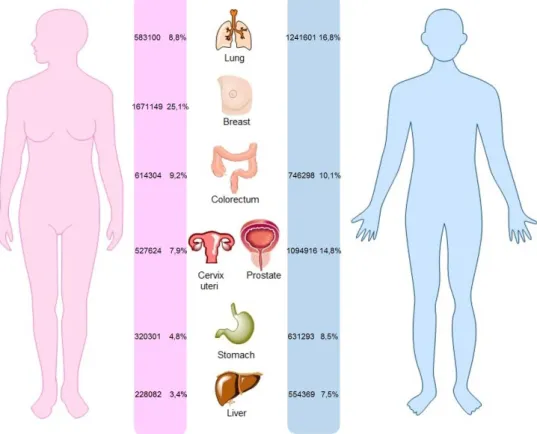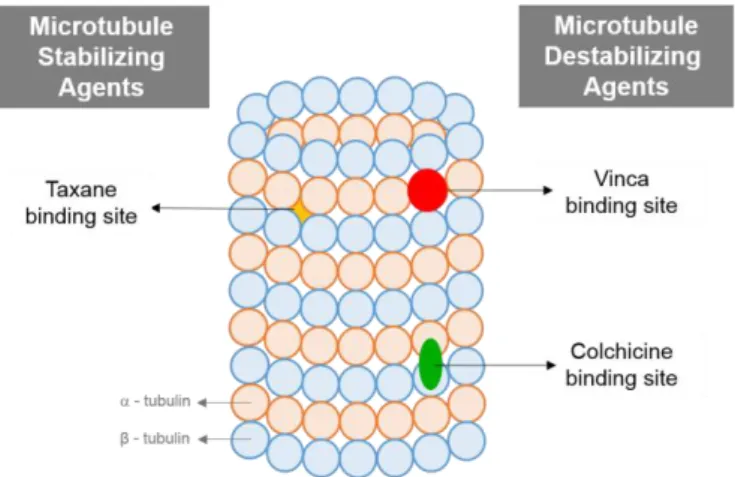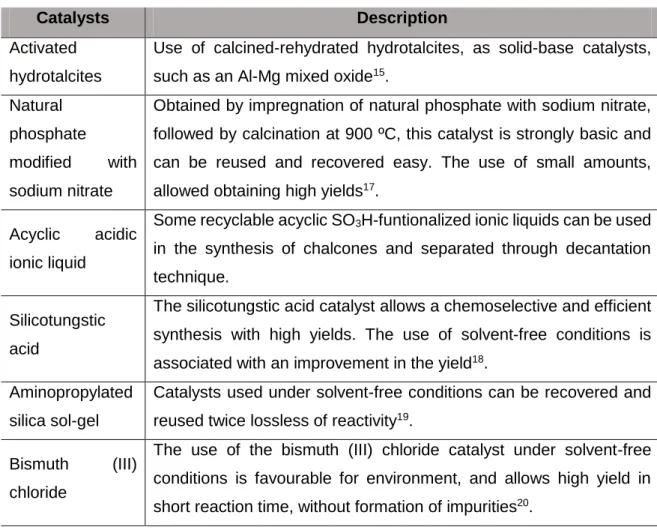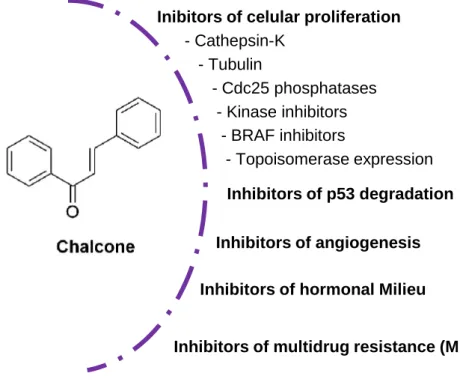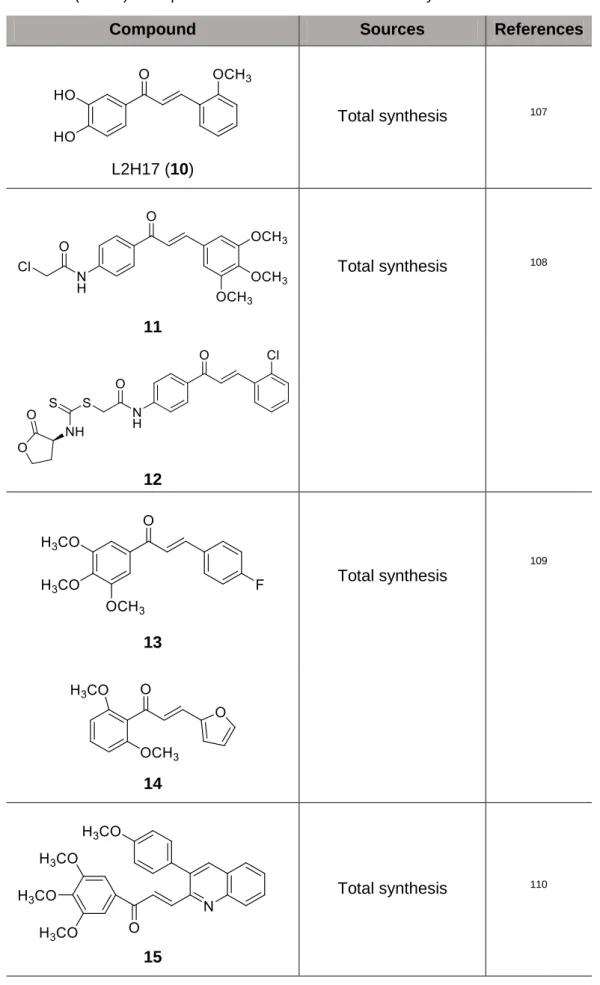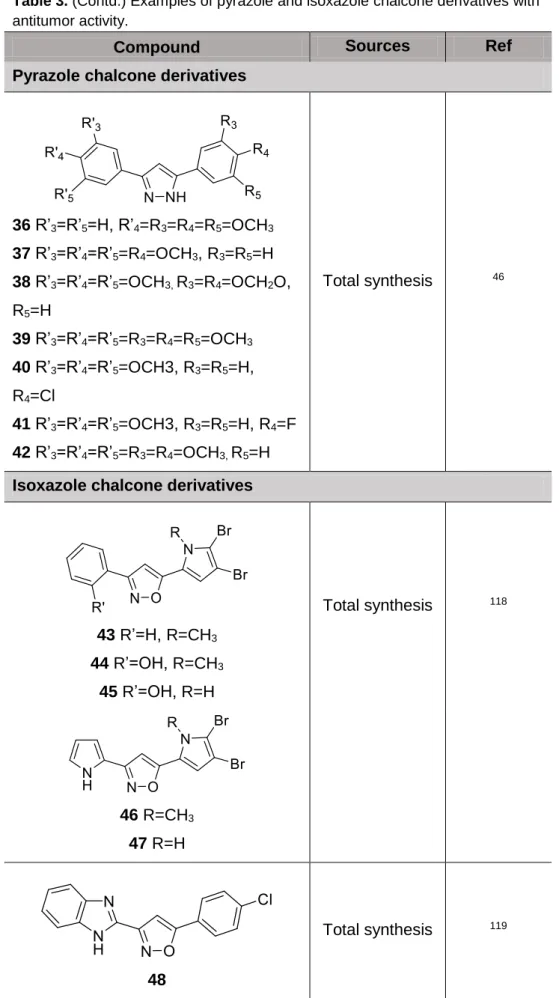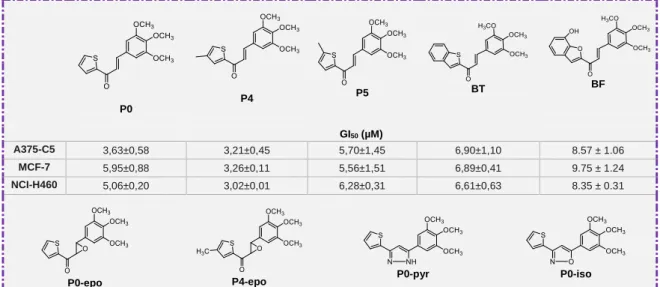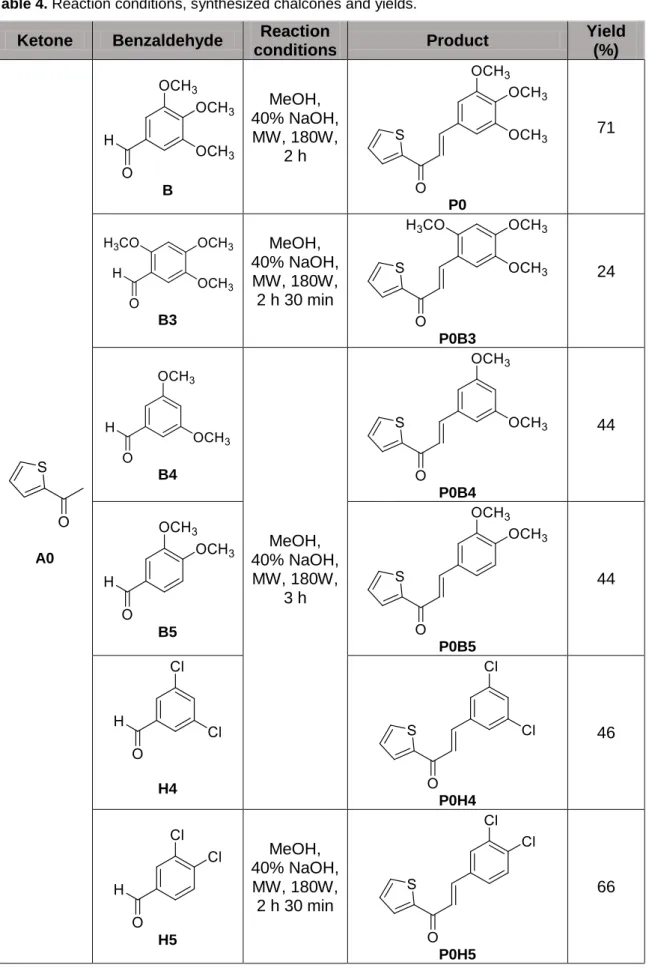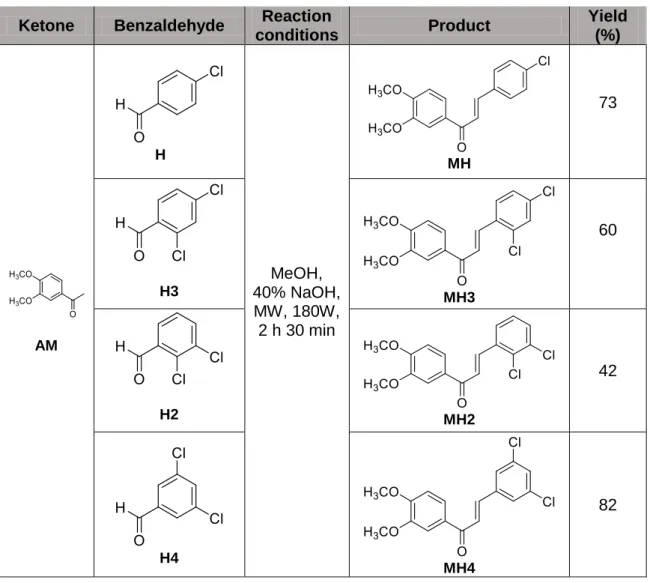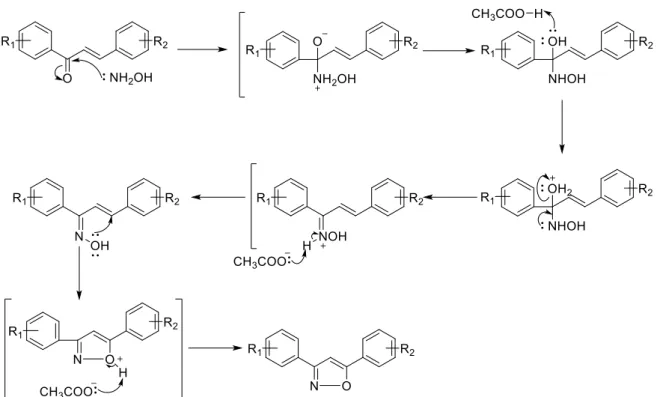Carmen Mariana Pimenta Carvalho Machado
Antitumor Chalcone Derivatives: Synthesis
and Biological Activity Evaluation
Dissertation presented to the Faculdade de Farmácia da Universidade do Porto, to obtain the degree of Master in Pharmaceutical Chemistry
Work developed under the scientific supervision of Professor Honorina Maria de Matos Cidade and Professor Patrícia Silva
ii
IN ACCORDANCE WITH THE APPLICABLE LAW, IS NOT ALLOWED TO
REPRODUCE ANY PART OF THIS THESIS.
iii This work was developed in Laboratório de Química Orgânica e Farmacêutica, Departamento de Ciências Químicas, Faculdade de Farmácia da Universidade do Porto and Instituto de Investigação e Formação Avançada em Ciências e Tecnologias da Saúde, Cooperativa de Ensino Superior Politécnico e Universitário (IINFACTS, CESPU). This research was developed under the projects PTDC/MAR-BIO/4694/2014, PTDC/AAG-TEC/0739/2014, and PTDC/DTPFTO/1981/2014 supported through national funds provided by Fundação da Ciência e Tecnologia (FCT/MCTES, PIDDAC) and European Regional Development Fund (ERDF) through the COMPETE – Programa Operacional Factores de Competitividade (POFC) programme (POCI‐ 01‐ 0145‐ FEDER‐ 016790, POCI-01-0145-FEDER-016793, POCl-01-0145-FEDER-016581), Reforçar a Investigação, o Desenvolvimento Tecnológico e a Inovação (RIDTI, Project 3599 and 9471), and INNOVMAR - Innovation and Sustainability in the Management and Exploitation of Marine Resources, reference NORTE-01-0145-FEDER-000035, Research Line NOVELMAR.
v
Poster communications
Some results presented in this dissertation are part of the following scientific communications:
Machado C.M.*, Pinto P., Silva P.M.A., Moreira J., Almeida D., Pinto M., Bousbaa H., Cidade H. "Heterocyclic chalcone derivatives: Synthesis and biological activity evaluation.” 12thYes Meeting - Young European Scientist Meeting, Porto, Portugal, 14-17 September 2017.
Machado C.M.*, Moreira J., Bartzoka A., Cidade H., Pinto M. “Chalcones isosteres: synthesis and structure elucidation.” 10th IJUP - Encontro Investigação Jovem da Universidade do Porto, Porto, Portugal, 9-10 February 2017.
Machado C.M.*, Moreira J., Bartzoka A., Cidade H., Pinto M. “Synthesis of promising bioactive chalcone derivatives.” Escola De Inverno De Farmácia - 2ª Edição, Porto, Portugal, 19-27 January 2017.
vii
Acknowledgements
Ao longo deste ano de dissertação, foram imensas as pessoas que estiveram presentes direta ou indiretamente. A todos os que contribuíram para a realização desta dissertação, tornando-a possível, agradeço o apoio científico, amizade, confiança e compreensão. No entanto, as minhas palavras de profunda estima e agradecimento dirigem-se à:
Professora Doutora Honorina Cidade, minha orientadora, por todo o conhecimento transmitido, pelo espírito crítico, pela partilha de ideias, e acima de tudo pelo apoio, incentivo, paciência, disponibilidade, ajuda e amizade ao longo do trabalho. O meu sincero muito obrigada!
Doutora Patrícia Silva, minha coorientadora, pela orientação, pelos valiosos ensinamentos, pela sua prontidão de auxílio, pela motivação, ajuda e amizade demonstrados ao longo do trabalho.
Professora Doutora Madalena Pinto, diretora do Mestrado em Química Farmacêutica, pela sua simpatia, disponibilidade e rigor científico.
Professor Doutor Hassan Bousbaa pela oportunidade que me proporcionou, por todo o conhecimento transmitido, espírito crítico e estímulo no decorrer do trabalho.
Drª Sara Cravo pelo apoio que me disponibilizou no laboratório sempre que necessitei, pelas opiniões científicas, mas também por todo o trabalho desenvolvido em HPLC, obrigada.
Gisela Adriano e à Liliana pela prontidão no que necessitei no laboratório, pela simpatia e amizade.
À Patrícia Pinto, Joana Moreira, Diana Roberta e Diogo Almeida pela colaboração, auxílio e disponibilidade em ajudar-me em tudo o que precisei. Foi muito importante o vosso apoio.
Aos meus colegas e amigos do laboratório, pelo companheirismo, cooperação e bons momentos partilhados, em especial à Beatriz, Álvaro, Ivanna, João e Ana Henriques.
viii
Aos meus Pais agradeço todo o apoio, dedicação, paciência, força, compreensão e presença incansável ao longo de todo o meu percurso e amor infinito que me proporcionam desde sempre. Obrigada por me terem incutido os melhores valores.
E um muito especial, à minha Irmã. Agradeço todo o apoio, a imensa paciência e compreensão, o carinho e a presença incansável ao longo do meu percurso. Obrigada por estares sempre junto de mim, és o meu orgulho! Sei que posso contar sempre contigo.
MUITO OBRIGADA.
“Nada se obtém sem esforço; tudo se pode conseguir com ele.”
ix
Abstract
Cancer is one of the leading causes of death in the world and, in recent years, new compounds with promising antitumor activity have been investigated, namely chalcones. The promising biological activities of natural chalcones have prompted the development of several synthetic approaches to synthesize chalcone derivatives. Additionally, the presence of an α,β-unsaturated ketone moiety make these compounds as intermediates for the synthesis of diverse heterocyclic derivatives, namely isoxazoles and pyrazoles.
As a continuation of the search of new antitumor small molecules by the LQOF-FFUP/CIIMAR research group, sixteen structurally related chalcones were synthesized by Claisen Schmidt condensation under microwave irradiation. In addition, isoxazole (P0-iso, P4-iso), epoxide (P0-epo, P4-epo), and pyrazole (P0-pyr, P4-pyr) derivatives were obtained through molecular modification of the ,β-unsaturated carbonyl system of two previously synthesized chalcones.
All compounds were evaluated for their antiproliferative activity in three human tumor cell lines, A375-C5 (melanoma), MCF-7 (breast adenocarcinoma) and NCI-H460 (non-small cell lung cancer), by the sulforhodamine B assay (SRB). In vitro screening results showed that some compounds have potent antiproliferative activity on human tumor cell lines, with GI50 values lower than 10 μM.
Moreover, the antimitotic effect of a previously synthesized chalcone (BF) in non-small cell lung cancer (NCI-H460) cell line was evaluated. The results suggested that BF exerts its antiproliferative effect by blocking mitotic progression of NCI-H460 cells, interfering with the assembly of spindle microtubules. Additionally, after prolonged treatment with BF, NCI-H460 cells presented abnormal nuclear morphology suggesting cell death by apoptosis. Thus, these results support the possibility of this chalcone to disrupt the microtubule assembly behaving as a potential antimitotic agent.
xi
Resumo
O cancro é uma das principais causas de morte no mundo e, nos últimos anos, novos compostos com atividade antitumoral foram investigados, nomeadamente calconas. As promissoras atividades biológicas descritas para estes produtos naturais encorajaram o desenvolvimento de métodos de síntese para obter análogos sintéticos. Adicionalmente, a presença nas calconas de uma cetona ,β-insaturada, torna estes compostos intermediários para a síntese de derivados heterocíclicos, nomeadamente isoxazóis e pyrazóis.
Como continuação da pesquisa de novas pequenas moléculas antitumorais pelo grupo de pesquisa do LQOF-FFUP/CIIMAR, dezasseis calconas estruturalmente relacionadas foram sintetizadas por condensação de Claisen Schmidt sob irradiação microondas. Além disso, derivados isoxazóis (P0-iso, P4-iso), epóxidos (P0-epo, P4-epo) e pirazóis (P0-pyr, P4-pyr) foram obtidos através da modificação molecular do sistema carbonilo ,β-insaturado de duas calconas previamente sintetizadas.
Os compostos foram avaliados relativamente à sua atividade antiproliferativa em três linhas celulares tumorais humanas, A375-C5 (melanoma), MCF-7 (adenocarcinoma da mama) e NCI-H460 (cancro de células não pequenas do pulmão), pelo ensaio da sulforrodamina B. Os resultados da triagem in vitro mostraram que alguns compostos apresentam potente atividade antiproliferativa em linhas celulares tumorais humanas, com valores de GI50 menores que 10 μM.
Além disso, foi avaliado o efeito antimitótico da calcona BF na linha celular de cancro de células não pequenas do pulmão NCI-H460. Os resultados revelaram que BF exerce o seu efeito antiproliferativo bloqueando a progressão mitótica das células NCI-H460, interferindo na formação do fuso mitótico. Adicionalmente, verificou-se que após o prolongamento do tratamento das células com BF, estas apresentaram uma morfologia nuclear anormal, sugestiva de morte celular por apoptose. Estes resultados suportam a possibilidade desta calcona ser um potencial agente antimitótico, mediante a interferência com a formação do fuso mitótico.
xiii
Table of contents
Acknowledgements ... vii
Abstract ... viii
Resumo ... xi
Table of contents ... xiii
List of Tables ... xv
List of Figures ... xvii
List of Schemes ... xix
Abbreviations and Symbols ... xxi
Chapter 1- Introduction ... 1
1.1. Cancer and mitosis ... 3
1.2. Antimitotic agents ... 5
1.3. Chalcones ... 6
1.3.1. Methods of synthesis of chalcones ... 8
1.3.1.1. Synthesis of chalcones by Claisen-Schmidt reaction ... 9
1.3.1.2. Synthesis of chalcones using borontrifluoride – etherate ... 10
1.3.1.3. Synthesis of chalcones by microwave irradiation ... 10
1.3.1.4. Synthesis of chalcones by Suzuki coupling reaction ... 11
1.3.1.5. Synthesis of chalcones by direct cross-coupling reaction ... 12
1.3.1.6. Synthesis of chalcones by Friedel-Crafts acylation ... 12
1.3.1.7. Synthesis of chalcones by Julia-Kocienski olefination ... 12
1.3.1.8. Synthesis of chalcones by grinding technique ... 13
1.3.2. Chalcones as intermediates for the synthesis of nitrogen heterocycles ... 13
1.3.2.1. Synthesis of isoxazoles ... 13
1.3.2.2. Synthesis of pyrazoles ... 14
1.3.3. Chalcones as promising antitumor agents ... 17
1.3.4. Chalcone derivatives as promising antitumor agents ... 26
1.4. Aims and overview ... 29
Chapter 2- Results and Discussion ... 31
2.1. Synthesis ... 33
2.1.1. Synthesis of chalcones ... 33
2.1.2. Molecular modification chalcone derivatives ... 37
2.1.2.1. Synthesis of isoxazole derivatives ... 37
2.1.2.2. Synthesis of pyrazole derivatives ... 39
xiv
2.2.1. Chalcones ... 41
2.2.2. Isoxazole derivatives P0-iso and P4-iso ... 47
2.2.3. Chalcone epoxides P0-epo and P4-epo ... 49
2.2.4. Pyrazole derivatives P0-pyr and P4-pyr ... 51
2.3. Evaluation of the antiproliferative activity ... 53
2.4. Characterization of BF antiproliferative activity ... 56
2.4.1. NCI-H460 cells arrest in mitosis in response to BF treatment ... 56
2.4.2. Mitotic spindle morphology is affected by BF ... 57
2.4.3. Assessment of cell fate after prolonged treatment with BF ... 59
Chapter 3- Conclusion ... 61
Chapter 4- Experimental ... 65
4.1. Synthesis ... 67
4.1.1. General Methods ... 67
4.1.2. Synthesis of chalcones ... 68
4.1.3. Synthesis of isoxazole derivatives ... 73
4.1.4. Synthesis of epoxide derivatives ... 74
4.1.5. Synthesis of pyrazole derivatives ... 74
4.2. Antitumor activity evaluation ... 76
4.2.1. Cell Culture ... 76
4.2.1.1. Cell lines and subculture conditions ... 76
4.2.1.2. Cell line freezing... 77
4.2.1.3. Cell line thawing ... 77
4.2.2. Evaluation of the antiproliferative activity ... 77
4.2.2.1. Compound preparation... 77
4.2.2.2. SRB colorimetric assay ... 77
4.2.3. Characterization of BF antiproliferative activity ... 78
4.2.3.1. Determination of antimitotic activity ... 78
4.2.3.2. Poly-L-Lysine coated coverslips ... 78
4.2.3.3. Indirect Immunofluorescence ... 79
4.2.3.4. Image acquisition and processing ... 79
4.2.4. Statistical analysis ... 80
xv List of Tables
Table 1. Some catalysts used in Claisen-Schmidt Reaction. ... 9
Table 2. Examples of chalcones with antitumor activity. ... 23
Table 3. Examples of pyrazole and isoxazole chalcone derivatives with antitumor activity. ... 27
Table 4. Reaction conditions, synthesized chalcones and yields. ... 34
Table 5. Reaction conditions for the synthesis of isoxazole derivatives P0-iso and P4-iso. ... 38
Table 6. IR data of chalcones. ... 42
Table 7. 1H NMR data of chalcones P0, P0B3, P0B4, P0B5, P0H4 and P0H5. ... 43
Table 8. 1H NMR data of chalcones P4, P4B3, P4B4, P4B5, P4H4 and P4H5. ... 44
Table 9. 1H NMR data of chalcones MH, MH3, MH2 and MH4. ... 44
Table 10. 13C NMR data of chalcones P0, P0B3, P0B4, P0B5, P0H4, P0H5, P4, P4B3, P4B4, P4B5, P4H4, P4H5, MH, MH3, MH2, MH4. ... 46
Table 11. IR data of isoxazole derivatives P0-iso and P4-iso. ... 47
Table 12. 1H NMR and 13C NMR data of isoxazole derivatives P0-iso and P4-iso. ... 48
Table 13- IR data of epoxide derivatives P0-epo and P4-epo. ... 49
Table 14 – 1H NMR and 13C NMR data of chalcones epoxides P0-epo and P4-epo. ... 50
Table 15- IR data of pyrazole derivatives P0-pyr and P4-pyr. ... 51
Table 16- 1H NMR and 13C NMR data of pyrazole derivatives P0-pyr and P4-pyr. ... 52
Table 17. Growth inhibitory effect of tested compounds on human cancer cell lines, upon 48 h exposure. ... 53
xvii List of Figures
Figure 1. Estimated of the incidence of the most frequent types of cancer in 2012. ... 3
Figure 2. Tubulin binding sites. ... 5
Figure 3. Chalcones scaffold. ... 6
Figure 4. Some molecular targets described for chalcones antitumor activity. ... 17
Figure 5. Chalcone derivatives previously synthesized and studied for their antiproliferative activity120*. ... 29
Figure 6. The numbering of synthesized compounds concerning the NMR assignments. ... 41
Figure 7. Main correlations found in the HMBC spectra of isoxazole derivatives P0-iso and P4-iso. ... 48
Figure 8. Main correlations found in the HMBC spectrum chalcones epoxides P0-epo and P4-epo. ... 50
Figure 9. Main correlations found in the HMBC spectra of pyrazole derivatives P0-pyr and P4-pyr. ... 52
Figure 10. Treatment with BF arrests NCI-H460 cells in mitosis.. ... 57
Figure 11. BF treatment affects mitotic spindle morphology. ... 58
xix List of Schemes
Scheme 1. Chalcone biosynthesis ... 7
Scheme 2. Methods of synthesis of chalcones. ... 8
Scheme 3. Method of Synthesis of chalcones via Suzuki coupling reaction. ... 11
Scheme 4. Synthesis of isoxazole derivatives through molecular modifications of chalcones. ... 14
Scheme 5. Synthesis of pyrazoles derivatives through molecular modifications of chalcones. ... 15
Scheme 6. Synthesis of pyrazoles using chalcones tetrabromides. ... 16
Scheme 7. Mechanism of Claisen Schmidt condensation. ... 33
Scheme 8. Synthesis of isoxazole and pyrazole derivatives. ... 37
Scheme 9. Plausible mechanism for the synthesis of isoxazole derivatives. ... 38
Scheme 10. Synthesis of pyrazole derivatives P0-pyr and P4-pyr. ... 39
xxi Abbreviations and Symbols
13C NMR Carbon nuclear magnetic resonance 1H NMR Proton nuclear magnetic resonance
4CL 4-coumarate CoA-ligase
ABC ATP-binding cassette
ABCG2 ATP-binding cassette subfamily G member 2 ACC Acetyl-CoA carboxylase
ADP Adenosine diphosphate
Akt Protein kinase B
APC/C Anaphase Promoting Complex/Cyclosome ATP Adenosine triphosphate
BCRP Breast cancer resistance protein Bax Bcl-2 associated X protein Bcl-2 B cell lymphoma 2
Brs Broad singlet
Bub Budding uninhibited by benzimidazole
C4H Cinnamate 4-hydroxylase
CC Column chromatography
CD-spectra Circular dichroism spectra Cdc20 Cell division control protein 20 Cdc25 Cell division control protein 25 Cdk1 Cyclin-dependent kinase 1
CHS Chalcone synthase
CIIMAR Centro Interdisciplinar de Investigação Marinha e Ambiental
CoA Coenzyme A
COX-2 Cyclooxygenase 2
d Doublet
Dd Double doublet
DAPI 4′,6-Diamidino-2-phenylindole dihydrochloride DMSO Dimethyl sulfoxide
DNA Deoxyribonucleic acid
EGFR Epidermal growth factor receptor
ERK Extracellular signal-regulated protein kinase
FBS Fetal Bovine Serum
xxii
GI50 Concentration of compound that inhibited 50% of the cell growth GTP Guanosine triphosphate
H Hours
HMBC Heteronuclear multiple bond correlation HPLC High performance liquid chromatography HRMS High resolution mass spectrometry HSQC Heteronuclear single quantum coherence HTIB Hydroxy(tosyloxy)iodobenzene
IC50 Concentration of Compound that causes 50% of inhibition ICAM-1 Intercellular adhesion molecule 1
IR Infrared spectroscopy
J Coupling constant
JNK c-Jun N-terminal kinases
LQOF-FFUP Laboratório de Química Orgânica e Farmacêutica da Faculdade de Farmácia da Universidade do Porto
Mad Mitotic arrest deficient MCC Mitotic Checkpoint Complex Mcl-1 Myeloid cell leukemia 1 MDM2 Murine double minute 2 MDR Multidrug resistance
MDR-1 Multidrug resistance protein 1
MI Mitotic índex
Min Minutes
MMP-9 Matrix metalloproteinase-9 MMPs Matrix metalloproteinases
Mp Melting point
MPM Malignant pleural mesothelioma mRNA Messenger ribonucleic acid
MTAs Microtubule-targeted antimitotic agents
MW Microwave
NCI National Cancer Institute NF-κB Nuclear factor kappa B NMR Nuclear Magnetic Resonance PARP Poly (ADP-ribose) polymerase PBS Phosphate Buffer Saline
xxiii PEG Poly(ethyleneglycol)
P-gp P-glycoprotein
PI Propidium Iodide
QSAR Quantitative structure-activity relationship
RP-HPLC Reversed-phase high-performance liquid chromatography
r.t. Room temperature
RPMI Roswell Park Memorial Institute
S Singlet
SAC Spindle assembly checkpoint SAR Structure-activity relationship
SD Standard deviation
Sp1 Specificity protein 1
SRB Sulforhodamine B
STAT3 Signal transducer and activator of transcription 3
T Triplet
TAL L-tyrosine ammonia-lyase TCA Trichloroacetic acid
TLC Thin layer chromatography
Tris Tris(hydroxymethyl)aminomethane
TUNEL Terminal deoxynucleotidyl transferase-mediated nick end labeling uPA Urokinase plasminogen activator
UV-Vis Ultraviolet-visible
UK United Kingdom
USA United States of America
VEGF Vascular endothelial growth factor WHO World Health Organization
wt p53 Wild-type p53
Δ Chemical shift
δC Carbon chemical shift
δH Proton chemical shift
3 1.1. Cancer and mitosis
Cancer is the second leading cause of mortality and morbidity, posterior to the cardiovascular disease, worldwide. In 2012, approximately 14.1 million new cancer cases, 8.2 million cancer deaths and 32.6 million people living with cancer (within 5 years of diagnosis) were present worldwide1, 2. The types of cancer with more incidence in 2012 were lung, breast, colorectum, prostate, cervix uteri, stomach and liver cancers (Figure 1)1.
Tobacco use, alcohol use, high body mass index, low fruit and vegetable intake, and lack of physical activity are the five leading behavioural and dietary risks, responsible by around one third of cancer deaths. Therefore, it is expected an increase of about 70% of the number of new cancer cases over the next two decades, being estimated 22 million of new cases1, 2.
World Health Organization (WHO) defines the cancer not as an only diseases, but as a generic term for a great group of diseases that can affect any part of the body. One characteristic that allows define the cancer is the fact of the abnormal cells were created of rapid form, growing beyond their usual boundaries, and thus can invade adjoining parts of the body and spread to others organs2.
4
Cell division is a complex process in which a series of highly coordinated events occurs, in which cellular components are double, and then segregated with precision into two genetically identical daughter cells3, 4. For a correct cell division, the main requirement is the correct functioning of the mitotic spindle during a mitosis. Mitotic spindles are aggregates of microtubule, who originate at centrosome that coordinate the movement of chromosomes during mitosis5.
Microtubules are long, filamentous, protein polymers, composed of α-tubulin and β-tubulin heterodimers, arranged parallel to a cylindrical axis to form tubes that can be many micrometres long6. They play an essential role in several eukaryotic cellular process, such as cell division and mitosis, the development and maintenance of cell shape, intracellular trafficking, and cell signalling6, 7. These are highly dynamic polymers and their polymerization are tightly regulated, and occurs through a nucleation-elongation mechanism in which a short microtubule "nucleus" is slowly formed, followed by rapid elongation at the ends of the microtubule by reversible, non-covalent addition of α- and β-tubulin dimers.
In mitosis, the equal segregation of the duplicated chromosomes allows the correct distribution of genetic information to two daughter cells3. This process of accurate segregation relies of mechanism of the spindle assembly checkpoint (SAC) that reduces of error rate during cell division8.
The SAC inhibits metaphase to anaphase transition blocking cell cycle, when there are non-attached or mis-attached kinetochores to microtubules, or chromosomes are not correctly bi-orientated and aligned at the metaphase plate. In these situation, is given to the cell some time for the error correction and chromosome bi-orientation3, 8.
The SAC is activated by the presence of unattached or improperly attached kinetochores9. These kinetochores recruits Mad2, Mad3/BubR1 and Bub3 proteins to the generation of the mitotic checkpoint complex (MCC), responsible for the sequestering of Cdc20, and thus keeps the anaphase promoting complex/cyclosome (APC/C) inactive. As a consequence, the inactivation of APC/C prevents the degradation of the securin and cycline B proteins, keeping, in this way, sister-chromatid cohesion and mitotic arrest. Once the last kinetochore becomes aligned, the SAC is silenced through disassembly of MCC, and Cdc20 becomes free to bind activate APC/C, which lead to securin and cyclin B degradation. Degradation of securin, an inhibitor of the protease separase, leads to cohesin and sister-chromatid separation, whereas cyclin B degradation leads to inactivation of cyclin-dependent kinase 1 (Cdk 1) activity, which drives mitotic exit3, 9.
The activity of SAC is crucial for equal segregation of genetic material. When the error is adequately solved, the SAC is silenced and the cell progresses into anaphase; otherwise, the more common result is the cell death via apoptosis.
5 1.2. Antimitotic agents
Microtubules are essential for mitosis, being an important target for anticancer drugs. The microtubule-targeting agents exert their effect on cell proliferation by induction of cell cycle arrest in G2-M phase, being also known as antimitotic agents.
Microtubule-targeted antimitotic agents (MTAs) are usually classified into two main groups, the microtubule destabilizing agents and the microtubule stabilizing agents. The microtubule destabilizing agents, such as the vinca alkaloids and colchicine, inhibit microtubule polymerization at high concentrations, and therefore inhibit cell proliferation at metaphase during mitosis. The microtubule stabilizing agents, such as taxanes (paclitaxel and docetaxel), stimulate microtubule polymerization5, 6, 10.
Most of antimitotic agents act in three different microtubule binding sites, the vinca domain, the taxane and the colchicine binding sites (Figure 2). The vinca domain is located at the plus end interface on the exchangeable GTP binding site in β-tubulin, the taxane binding site is within the lumen of the microtubule, situated in a deep hydrophobic pocket at the lateral interface between adjacent protofilaments, and the colchicine binding site is situated at the intra-dimer interface between -tubulin and β-tubulin5.
Figure 2. Tubulin binding sites.
MTAs exert their effect through the suppression of microtubule dynamics, resulting in the spindle formation impairment. Consequently, improper attachment between microtubules and kinetochores occur, causing SAC activation, leading to mitotic progression blocking. This stationary situation of cells in a SAC-dependent manner is temporary, during upon a span of hours, and these cells are driven into programmed cell death. Microtubules are, therefore, important straightforward targets for cancer therapy. Although several MTAs have been commonly used in cancer treatment, their clinical
6
efficacy has been impaired by various side effects and drug resistance, being needed to discover new MTAs agents.
1.3. Chalcones
Chalcones (1,3-diphenylpropan-1-ones) are the initial intermediate structures for the biosynthesis of all flavonoids11. They are open-chain flavonoids constituted by two aromatic rings (A and B) linked through a three-carbon α,β-unsaturated carbonyl system11, 12, 13 (Figure 3).
A great number of natural chalcones are polyhydroxylated in the aromatic rings. Usually, chalcones have hydroxyl group at C2’-, C4’, and/or C6’-positions in A-ring. The B-ring generally has a hydroxyl group at C4-position. Some chalcones do not have an oxygen function at the 2’-position, being called as retrochalcones. Other common substituents for natural chalcones include prenyl and methoxyl groups11.
Chalcones are biosynthesized through the convergence of two pathways, the acetate-malonate and shikimate pathways, which give rise to the A- and B- rings, respectively (Scheme 1)11, 12. Biosynthesis of chalcones starts with the remotion of the amino group of L-phenylalanine, produced via the shikimate pathway, producing cinnamic acid, which afterward, undergoes two stepwise enzymatic conversions catayzed by cinnamate 4-hydroxylase and 4-coumarate CoA-ligase leading to 4-coumaroyl-CoA11, 12, 14. Claisen-like condensation of 4-coumaroyl-CoA with three molecules of malonyl-CoA forms a tetraketide intermediate, which is cyclized to afford a chalcone, being these reactions catalysed by chalcone synthase (CHS)11, 14.
7
Scheme 1. Chalcone biosynthesis. ACC, acetyl-CoA carboxylase; TAL, L-tyrosine ammonia-lyase;
PAL, L-phenylalanine ammonia-lyase; C4H, cinnamate 4-hydroxylase; 4CL, 4-coumarate CoA-ligase; CHS, chalcone synthase.
8
1.3.1. Methods of synthesis of chalcones
Considering that chalcones are an important group of natural products with a wide range of biological activities and act as precursors in the synthesis of numerous compounds, synthetic strategies leading to natural mimic chalcones along with new and more diverse and complex molecules have been extensively reported in the past years. The main methodologies used are summarized in the next sub-sections (Scheme 2).
Scheme 2. Methods of synthesis of chalcones. a) Claisen-Schmidt reaction; b) using
borontrifluoride-etherate; c) via Suzuki coupling reaction; d) Direct cross-coupling reaction; e) Friedel-Crafts Acylation; f) Julia-Kocienski olefination.
9 1.3.1.1. Synthesis of chalcones by Claisen-Schmidt reaction
The Claisen-Schmidt condensation is the method usually used for synthesizing chalcones. In this method chalcones are synthesized by condensation of acetophenone and benzaldehyde derivatives resulting in the formation of a α,β-unsaturated ketone moiety linking two aromatic rings A and B, derived from the acetophenone and benzaldehyde derivatives, respectively (Scheme 2; a). Usually, the benzaldehyde derivative is used in excess and the formation of chalcones is easily detected by the appearance of a yellow colour in the reaction mixture15. In this reaction occurs the nucleophilic addition of carbanion derived from the aryl ketones to carbonyl carbon of the aromatic aldehydes16.The high accessibility of commercial acetophenone and benzaldehyde derivatives makes this method the most used to synthesize this class of flavonoids.
The Claisen-Schmidt reaction is typically carried out in the presence of an aqueous, methanolic or ethanolic alkaline solution, at room temperature or at reflux for several hours. Nevertheless, other catalysts have been developed for this reaction (Table 1).
Table 1. Some catalysts used in Claisen-Schmidt Reaction.
Catalysts Description
Activated hydrotalcites
Use of calcined-rehydrated hydrotalcites, as solid-base catalysts, such as an Al-Mg mixed oxide15.
Natural phosphate
modified with sodium nitrate
Obtained by impregnation of natural phosphate with sodium nitrate, followed by calcination at 900 ºC, this catalyst is strongly basic and can be reused and recovered easy. The use of small amounts, allowed obtaining high yields17.
Acyclic acidic ionic liquid
Some recyclable acyclic SO3H-funtionalized ionic liquids can be used in the synthesis of chalcones and separated through decantation technique.
Silicotungstic acid
The silicotungstic acid catalyst allows a chemoselective and efficient synthesis with high yields. The use of solvent-free conditions is associated with an improvement in the yield18.
Aminopropylated silica sol-gel
Catalysts used under solvent-free conditions can be recovered and reused twice lossless of reactivity19.
Bismuth (III) chloride
The use of the bismuth (III) chloride catalyst under solvent-free conditions is favourable for environment, and allows high yield in short reaction time, without formation of impurities20.
10
Table 1. (Contd.) Some catalysts used in Claisen-Schmidt Reaction.
Catalysts Description
Modified hydroxyapatite with sodium nitrate
A small amount of sodium nitrate/hydroxyapatite, in gentle conditions at room temperature and with addition of a quaternary ammonium salt, allows the increase of yield. This catalyst is of easy regeneration and reuse21.
NaOH-Al2O3
The use of the NaOH-Al2O3 as catalyst, without using solvent, have advantages as quick reaction, gentle conditions of the reaction and good yields22.
Brønsted acidic ionic liquids are dual catalyst
Brønsted acidic ionic liquids have catalytic and reusable capabilities23.
1.3.1.2. Synthesis of chalcones using borontrifluoride – etherate
The method using Borontrifluoride – Etherate was developed by Narender and Reddy, in 2007, to synthesize various chalcones. Alternatively to the base catalysed Claisen Schimdt reaction, chalcones are obtained by reaction between various substituted acetophenones and aromatic aldehyde, with BF3-Et2O as catalyst, within 15-150 minutes (Scheme 2; b)24.
This method has many advantages in relation with classic Claisen Schmidt condensation reactions in the presence of the KOH or NaOH , such as high yields, simple work-up, short reaction times, no side reactions and can be used in the presence of sensitive functional groups (amides and esters)24. In addition, this method can be used in solvent-free reactions.
1.3.1.3. Synthesis of chalcones by microwave irradiation
The use the microwave (MW) irradiation in synthesis is popular by researchers because fastens the organic reactions and it presents advantages over conventional heating methods such as short reaction time, high selectivity, easy work up and cleaner products25. In addition, solvent free reactions can be carried out by MW irradiation, making these method an attractive alternatively to the conventional heating26. Therefore, MW
11 irradiation has been used in the synthesis of chalcones by condensation between acetophenone and benzaldehyde derivatives, in presence of anhydrous potassium carbonate in free-solvent conditions. The anhydrous K2CO3 is cheap, non-toxic and easy to use in contrast to more strong bases such as NaOH or KOH, used in classic Claisen Schmidt reactions, which are harmful, toxic and polluting. Using this methodology Srivastava et al. synthesized several chalcone derivatives in good yields26.
Beyond the anhydrous K2CO3, other catalysts with similar advantages have been used, such as TiO2-SO42- and re-usable hydroxyapatite. The TiO2-SO42- is prepared by sol-gel method through H2SO4, which increase the acidity of TiO2 due to the sulphate present27. The hydroxyapatite is used as heterogeneous catalyst, having high reactivity because the water combined with hydroxyapatite operates as co-catalyst28.
1.3.1.4. Synthesis of chalcones by Suzuki coupling reaction
Suzuki reaction is an important tool used for the construction of C-C bond, which is based on the coupling between organoboron compounds and organic halides or triflates, catalyzed by palladium in the presence of base29. This reaction has been used for the synthesis of several compounds30, including chalcones.
The method of synthesis of chalcones via Suzuki Coupling Reaction by the coupling either between cinnamoyl chlorides and phenylboronic acids (Scheme 3; a) or between benzoyl chlorides and phenylvinylboronic acid (Scheme 3; b) using several reaction conditions was first describe in 2003, by Eddarir et al.31.
Scheme 3. Method of Synthesis of chalcones via Suzuki coupling reaction.
Concerning the coupling between cinnamoyl chlorides and phenylboronic acids the best yields were obtained using anhydrous toluene as the solvent,
12
tetrakis(triphenylphosphine) as catalyst and cesium carbonate as base. The coupling between benzoyl chloride and phenylvinylboronic acid gave the unsubstituted chalcone in near quantitative yield, being the yield not affected by the substitution pattern of the benzoyl chlorides. In addition, when phenylvinylboronic acid possessing donor substituents was used in this reaction the expected chalcone was also obtained with good yields, as illustrated in Scheme 2; c)31.
1.3.1.5. Synthesis of chalcones by direct cross-coupling reaction
The direct cross-coupling reaction consist in the cross-coupling of the benzoyl chlorides and potassium styryltrifluoroborates with palladium-catalysed system under MW irradiation, allowing to obtain ,-unsaturated aromatic ketones through one pot synthesis. This method has been used for the first time by Al-Masum et al. for the synthesis of several chalcones using 1,4-dioxano as solvent and K2CO3 as base (Scheme 2; d)32. Although 1,4-dioxane is a non-polar solvent not typically used for MW irradiation reactions, the polarizability of the two oxygen and the relatively high boiling point is favourable for cross-coupling to occur.
This process present advantages, such as the fact that potassium styryltrifluoroborates are non-toxic, easily prepared and removable 32.
1.3.1.6. Synthesis of chalcones by Friedel-Crafts acylation
The chalcones can be synthesized by direct Friedel-Crafts acylation of a phenol. The phenol originates the chalcone A-ring while the acylating agent originates both the B-ring and the three carbon bridge between B-rings A and B (Scheme 2; e). Several catalysts have been used, namely anhydrous aluminum chloride25, 33.
1.3.1.7. Synthesis of chalcones by Julia-Kocienski olefination
This method has innovative role for the production of chalcones and flavanones, and consists in the condensation of aldehydes with 2-(benzo[d]thiazol-2-ylsulfonyl)-1-phenylethanones, new reagents developed for Julia-Kocienski olefination, in the presence of a base (Scheme 2; f). The product obtained has good yields34.
13 1.3.1.8. Synthesis of chalcones by grinding technique
Some chalcone derivatives have been obtained by grinding technique through the reaction of substituted 2-acetyl-1-naphthol and different substituted benzaldehydes in presence of base. This reaction has no need of catalyst, is non-hazardous and environmentally safer, giving excellent yield in short reaction time35.
1.3.2. Chalcones as intermediates for the synthesis of nitrogen heterocycles
The presence of an ,β-unsaturated carbonyl system in chalcone scaffold makes these derivatives as promising building blocks for the synthesis of interesting bioactive compounds, namely nitrogen heterocyclic derivatives. In fact, the enone moiety of chalcones possess two electrophilic carbon atoms, allowing the participation of chalcones in addition reactions through the attack to the carbonyl group (1,2-addition) or the β-carbon atom (1,4-conjugate addition) making these compounds versatile molecules for the synthesis of pyroles, isoxazoles, pyrazoles, indazoles, among others.
1.3.2.1. Synthesis of isoxazoles
Isoxazole derivatives constitute a unique class of nitrogen and oxygen containing five member heterocycles. They are associated with a wide spectrum of biological activities such as anti-inflammatory36, anticonvulsant37 , insecticidal38 and anticancer39 activities.
3,5-diarylisoxazoles have been synthetized through the reaction between chalcones and hydroxylamines, using NaOH or KOH as base40. Alternatively, these compounds have been obtained by the reaction of various chalcones with hydroxylamine hydrochloride in the presence of NaOAc and glacial acetic acid in ethanol (Scheme 4; a)41.
In 2012, Kamal et al., reported the two-step synthesis of 4,5-disubstituted isoxazoles. Chalcones were converted into the corresponding α,-ditosylate derivatives, which then reacted with hydroxylamine giving the isoxazoles (Scheme 4; b)42. Additionally, the synthesis of 3,5-isoxazoles has been achieved by the reaction of α,-dibromochalcones with hydroxylamine hydrochloride, in the presence of KOH (Scheme 4; c)43, 44.
3,4,5-Trisubstituted isoxazoles were synthesized using poly(ethyleneglycol) (PEG) as support. This reaction occurred between soluble-polymer-supported nitrile oxide
14
generated in situ and chalcones yielding the polymer-supported isoxazolines, which after were cleaved by sodium methoxide generating 3,4,5-trisubstituted isoxazoles, under mild reaction conditions (Scheme 4; d)45.
Scheme 4. Synthesis of isoxazole derivatives through molecular modifications of chalcones. HTIB,
Hydroxy(tosyloxy)iodobenzene.
1.3.2.2. Synthesis of pyrazoles
Pyrazoles are widely found as the core structure in a large variety of compounds that possess important agrochemical and biological activities. Among these biological activities, the antitumor activity has been systematically reported, being considered that the introduction of this ring in the chalcone scaffold is associated with an improved antitumor activity46.
Different synthetic methodologies have been developed to obtain these compounds, namely those related with the molecular modification of chalcones47.
15 The reaction of chalcones with dipolar molecules or 1,2-binucleophiles, such as hydrazine derivatives, is the most used method for the synthesis of pyrazoles. These one or two steps reactions are usually carried out in acidic conditions, using ethanol or acetic acid as solvent40.
Several examples of one-pot synthesis of pyrazoles derivatives have been reported in literature using different reaction conditions. Some derivatives have been synthesized by the reaction of chalcones with several hydrazine derivatives, including phenylhydrazine and hydrazine hydrate (Scheme 5; a)48.
Scheme 5. Synthesis of pyrazoles derivatives through molecular modifications of chalcones. HTIB,
Hydroxy(tosyloxy)iodobenzene.
In addition to classic methods, ecofriendly one-pot approaches have been used to synthesize pyrazole derivatives. In 2014, Zang et al., reported the synthesis of 2,3-diphenyl-1H-pyrazoles under mechanochemical ball-milling conditions, through reaction of chalcones with hydrazine hydrate, using sodium persulfate as the oxidant 49. Landge et al. developed a one-pot free-solvent synthesis of pyrazoles, through MW irradiation and using a bifunctional nobel-metal/solid-acid catalyst, Pd/C/K-10 montmorillonite , in the reaction of
16
chalcone and substituted hydrazine (Scheme 5; b)50. Using MW irradiation, a range of 3,5-disubstituted pyrazoles were prepared by the reaction of chalcones with hydrazine hydrate with better yields and shorter reaction times in comparison with conventional methods51, 52. In some approaches of two steps synthesis of pyrazole derivatives, chalcones were firstly converted into chalcone dibromides by treatment with bromine, and afterward these derivatives afforded pyrazoles by the reaction with benzoylhydrazines53, phenylhydrazines54 or hydrazine hydrate55 (Scheme 5; c). Instead of chalcone dibromides, chalcones tetrabromides have also been reported as intermediates for the synthesis of pyrazoles by refluxing these intermediates with hydrazine hydrate (Scheme 6)56.
An alternative approach to chalcone bromides is the synthesis of chalcone α, -ditosylates, which subsequently are transformed in 1,4,5-trisubstituted pyrazoles by the reaction of α,-ditosylate chalcones with phenylhydrazine hydrochloride, semicarbazide hydrochloride or thiosemicarbazide (Scheme 5; d)57.
The two steps reactions involving the synthesis of chalcones epoxides through reaction of chalcone derivatives with potassium carbonate or sodium hydroxide and H2O2 followed by the cycloaddition reaction of hydrazine hydrate with chalcone-epoxide have also been described as an effective procedure to obtain 3,5-diaryl-1H-pyrazoles (Scheme 5; e)58, 59.
17 1.3.3. Chalcones as promising antitumor agents
Chalcones are present in nature, in diverse species of plants, and exhibit an enormous interest among scientific community due to its simple structure, variety of substituents, and great range of pharmacological activities, such as antidiabetic60, antioxidant61, anti-inflammatory, antiarthritic, antiulcer62, antimalarial63, antimicrobial64, 65, 66 67, antileishmanial68, anti-tuberculosis69, antitumor70, and cardiovascular agents71.
Among these activities, the antitumor activity has been one of the most explored. The majority of the scientific publications concerning the antitumor activity of chalcones are mainly related to their in vitro growth inhibitory properties in several human tumor cell lines. However, given the importance of the antitumor activity of these compounds, several studies in order to get some insights into the molecular mechanism of action of these compounds have been performed and several molecular targets have been identified as described below (Figure 4).
Figure 4. Some molecular targets described for chalcones antitumor activity.
Chalcones are described as potent inhibitors of cellular proliferation, by the interference with several targets, namely those described below13.
Cathepsin–K is an enzyme expressed in human breast cancer, and its inhibition by some chalcone derivatives may contribute to the suppression of tumor spread in body and breast cancer72.
Inibitors of celular proliferation - Cathepsin-K - Tubulin - Cdc25 phosphatases - Kinase inhibitors - BRAF inhibitors - Topoisomerase expression Inhibitors of p53 degradation Inhibitors of angiogenesis Inhibitors of hormonal Milieu
18
Tubulin is the principal structural component of microtubules, which are cellular structures found in eukaryotic cells, being responsible for several functions, including mitosis. Chalcones can bind to tubulin preventing its polymerization, which is essential for mitosis, leading to a disruption in assembly of mitotic spindles and therefore to mitotic arrest13, 73.
Cdc25 phosphatases (Cdc25A, Cdc25B and Cdc25C) have major functions in cell cycle progression by activating cyclin-dependent kinases. Cdc25A plays an essential role at the G1/S phase transition, while Cdc25C is related in the dephosphorylation and activation of the mitotic kinase Cdc2/cyclinB. Cdc25B undergoes activation during S-phase and is a mitotic regulator that acts as a ‘starter phosphatase’ to initiate the positive feedback loop at the entry into M phase. Inhibition of Cdc25B phosphatase allows the inhibition of cell cycle in G2/S-phase and mitotic arrest occurs74, 75. Several reports have shown the inhibition of both Cdc25A and Cdc25B by chalcone derivatives76, 77.
The ErbB receptor tyrosine kinases (epidermal growth factor receptor (EGFR), ErbB2, ErbB3, and ErbB4) play important roles in cancer. Some of these kinases, such as EGFR are mutated in many tumors, and others are overexpressed in several human cancers, being therefore considered primary targets of anticancer strategies. Some chalcone derivatives have shown to reduce the protein and mRNA levels of ErbB3 and to inhibite ErbB phosphorylation13, 78, 79
BRAF is a gene that provides instructions for making a protein that helps transmit chemical signals from outside the cell to the cell's nucleus80. This protein regulates cell growth, proliferation, differentiation, migration and apoptosis. The mutation in the BRAF gene, results in the oncogenic BRAF which causes changes in the functions of the protein, yielding different types of cancer, like melanoma, papillary thyroid tumors, serous ovarian tumors, colorectal and prostate tumors. Therefore, inhibition of this gene by several compounds, including chalcone derivatives, may decrease tumor cell proliferation and increase tumor cell death13, 81, 82.
DNA topoisomerase II has been described as a major target for antineoplastic agents. This enzyme cut the chain of a double-stranded DNA molecule, in order to manage DNA tangles and supercoils. Therefore, inhibitors of topoisomerase II, such as chalcones, are potent inducers of double strand breaks in DNA, and can cause arrest in the cell cycle at the G2 phase83.
Tumor suppressor protein p53 is a multifunctional protein, which regulates cell proliferation, DNA repair, apoptosis, inhibition of angiogenesis, genomic stability and gene activation84, 85. The p53 pathway is one of the most commonly altered in human cancers. Although about half of all cancers retain wild-type p53 (wt p53), the p53 pathway is inactivated due to the overexpression of the main endogenous negative regulator, murine
19 double minute 2 (MDM2). MDM2 binds p53 and negatively regulates its activity, by direct inhibition of p53 transcriptional activity and enhancement of p53 degradation. The re-establishment of p53 activity by inhibition of its interaction with MDM2 represents an attractive therapeutic strategy for many wt p53 tumors with overexpression of MDM2. Proteasome, a multicatalytic proteinase complex, is responsible for the degradation of most of intracellular proteins, such as p53, that have been damaged, assembled improperly, or that are not useful for the cell. Inhibition of proteasomes leads to accumulation of p53 protein, promoting effective tumor suppression86. Some reports demonstrated that chalcone derivatives can disrupt the p53-MDM2 complex with the subsequent release of p53 87, 88, 89, as well as can inhibit the proteasome, leading to the accumulation of p5313.
Angiogenesis is the physiological processes in which new blood vessels are formed from pre-existing vessels, and their inhibition prevents activation of pro-angiogenic factors and subsequently the tumor progression halts13. The inhibition of vascular endothelial growth factor (VEGF), a signal protein produced by cells that stimulates angiogenesis, have been reported for some chalcone derivatives90. Additionally, the inhibition of vascular endothelial growth factor receptor 2, which mediate most of the endothelial growth and survival signals91, 92, as well as the inhibition of matrix metalloproteinases (MMPs), a family of enzymes that have the ability to degrade many molecules of the extracellular matrix93 has been described for chalcone derivatives.
Hormones play an important rule for the development of the hormone-related cancers, such as breast, endometrium, ovary, prostate and testis cancer. In this regard, chalcone derivatives have been described as interfering with the biosynthesis of several hormones, namely sex hormones such as testosterone and estrogen. In fact, several reports have described the chalcones inhibitory effects on 5α-testosterone94, 95 and aromatase96, as well as on androgen receptor13, 97.
The ATP-binding cassette (ABC) transporter proteins including ABCG2, BCRP and P-glycoprotein (P-gp) were described as molecular targets for chalcones13. ABCG2 is known to contribute to MDR in cancer chemotherapy including breast cancer, being particularly important for protecting cancer stem cells and its complex oligomeric structure98. BCRP proteins act as a defense mechanism against toxins and xenobiotic, facilitating excretion and limited absorption of potentially toxic substrate molecules, including many cancer chemotherapeutic drugs 99. P-gp, also known as multidrug resistance protein 1 (MDR-1), is a transmembrane permeability glycoprotein widely distributed throughout the body, which expels many foreign substances out of the cells by ATP-dependent efflux pump. Some cancer cells express large amounts of P-gp which renders these cancers multidrug resistant100.
20
As at the beginning of 2015, the antitumor activity of natural and synthetic chalcones was reviewed by Mahapatra et al.13 in this subchapter, are summarized some examples of natural and synthetic chalcones that have been referred in the last two years (Table 2).
Some oxathiole-fused chalcones 1-4 demonstrated significant cytotoxic activity against different tumor cells, namely A549 (adenocarcinoma), HCT116 ( colorectal carcinoma) and HeLa (cervix carcinoma), showing some of them IC50 lower than 1 µM. Studies on the mechanism underling this effect proved that these compounds disturbed polymerization of tubulin by binding to the colchicine binding site101. Using molecular modeling it was demonstrated that depending on the substitution pattern of the B ring and the alkoxy chain in position 6, chalcones can adopt distinct poses within colchicine binding domain of tubulin101.
Bittencout et al. synthesized three chalcones and study the effects on A172 (human brain glioblastoma) and GBM1 (glioblastoma) cell lines. All chalcones showed a decrease in cell viability in both cell lines. Chalcone 5 caused an augmentation on apoptosis levels and promoted cell cycle arrest at G0/G1 and S phases in A172 and GBM1 cells, respectively102. Moreover, an increased of reactive oxygen species and nitric oxide production was detected in cells treated with chalcone 5.
Butein (6), isolated from various plant sources, showed potential antiproliferative effect against a wide range of neoplasms and the molecular targets associated to this effect have been reviewed by Padmavathi et al.103, 104 Most often it affects the expression of NF-κB and its up-stream and downstream regulators. Other important molecular targets of
butein (6) include MMP-9, uPA, EGFR, COX-2, VEGF, STAT3, ERK, JNK, Akt, p38 and ICAM-1. In addition, butein (6) also modulates the expression of different proteins involved in apoptosis including Bax, Bcl-2, cytochrome c, and caspases. Besides inducing apoptosis, butein (6) also inhibits tumor migration, invasion and metastasis of different cancers like prostate, liver and bladder cancers103, 104.
In 2015, the ability of trans-chalcone (7) to reduce viability, induce apoptosis, and alter gene expression of p53 and specificity protein 1 (Sp1
)
in human osteosarcoma cell lines (U2OS, A549, 116, and FaDu) was evaluated. The incubation of U2OS and HCT-116 cell lines with 10 µM of chalcone 7 demonstrated an inhibition of the cell growth after 1, 2 and 4 days treatment, being this antiproliferative activity mediated by apoptosis induction. In addition, this chalcone affected Sp1 down-regulation at the transcriptional level, whereas trans-chalcone up-regulated p53 expression at the post-translational level105. Four new Ru(II) DMSO complexes with substituted chalcone ligands have been synthesized and screened for antiproliferative activity against breast cancer cell lines (MCF-7 and MDA MB-231). Compounds HL4 (8) and M1R (9) showed antiproliferative activity21 against breast cancer cells, being HL4 the most potent growth inhibitor against MDA MB-231 and M1R (9) the most potent inhibitor against MCF-7. Both derivatives arrested cells in the S phase in MCF-7 and G1-phase in MDA MB-231 cells, showing M1R (9) a more potent effect106. Moreover, UV–Vis and CD-spectra analysis showed that HL4 (8) and M1R (9) interfered with DNA absorption spectra possibly due to DNA binding, whereas these compounds were devoid of DNA topoisomerase inhibiting activity106.
Chalcone L2H17 (10) exhibited selective cytotoxic effect in both human (HCT 116) and mouse (CT26.WT) colon cancer cell lines. Treatment of CT26.WT cells with this compound resulted in G0/G1 cell cycle arrest and apoptosis and a decrease of cell migration and invasion. In addition, L2H17 (10) possessed marked in vivo antitumor activity. The proposed molecular mechanism of L2H17-mediated inhibition of tumor promotion and progression was related to the inactivation of NF-κB and Akt signalling pathways107.
Chalcones 11 and 12 were synthesized and evaluated for their in vitro cytotoxic activity against human cancer cell lines, including MGC-803 (human gastric cancer cell line), MCF-7 (human breast cancer cell line), EC-9706 (human oesophageal cancer cell line) and SMMC-7721 (human hepatocellular carcinoma cell line). Compound 11 , with a 3,4,5-trimethoxy group, showed excellent inhibition against all the tested cancer cell lines, and compound 12 induced the cellular apoptosis and cell cycle arrest of MCF-7 cells at G2/M phase108.
Starting from micromolar chalcone hits, a predictive QSAR model for diarylpropenones was developed, and several analogues with a 100-fold increase in potency were synthesized. Among these compounds, chalcones 13 and 14 proved to be the most interesting, combining nanomolar anti-invasive potency with a satisfactory pharmacological profile. Moreover, both compounds exhibited selective cytotoxicity towards MCF-7/6 cells at micromolar concentrations. Compound 13 prolonged survival in an artificial metastasis model in nude mice109.
3-Phenylquinolinylchalcone derivatives were synthesized and evaluated for their in
vitro antiproliferative activity against three breast cancer cell lines (MCF-7, MDA-MB-231,
and SKBR-3), and a non-cancer normal epithelial cell line (H184B5F5/M10). Derivative 15 was active against the growth of MCF-7, MDA-MB-231, and SKBR-3, without significant cytotoxicity to the normal H184B5F5/M10 cell line. Studies of the mechanisms involved in these effects indicated that this compound inhibited the polymerization of tubulin, induced G2/M cell cycle arrest via modulation of the cyclin B1, cdk1 and Cdc25, and induced cell apoptosis by the increase of apoptotic protein Bax and the decrease of the anti-apoptotic protein Bcl-2. Besides, protein poly (ADP-ribose) polymerase (PARP) was cleaved, while caspases-3 and -8 activities were induced after the treatment of tumor cells with this compound110.
22
Licochalcone A (16) isolated from the roots of Glycyrrhiza inflata revealed to be a potent tumor cell growth inhibitor in several human malignant pleural mesothelioma (MPM) cells, namely MSTO-211H, H28 MSTO-211H and H28 cell lines. Moreover, this chalcone negatively modulate Sp1 expression in MSTO-211H and H28 cell lines. Consistent with this down regulation of Sp1, expression of Sp1 regulatory proteins such as Cyclin D1, Mcl-1 and Survivin was substantially diminished. Mechanistically, Licochalcone A-mediated Sp1 down-regulation induced morphological changes of mitochondria, leading to apoptotic cell death111.
Prenylchalcone 17 obtained by the prenylation of 2′-hydroxy-3,4,4′,5,6′-pentamethoxychalcone revealed a more potent antiproliferative activity against human tumour cells than its building block. The impact of this prenylated chalcone and its precursor on p53–MDM2 interaction was investigated using yeast assays. Their tumour growth-inhibitory effects were assessed on human colon adenocarcinoma HCT116 cell lines with wild-type p53 and its p53-null derivative, followed by analysis of cell cycle and apoptosis. The potent cell tumour growth-inhibitory activity of chalcone 17 was associated with the activation of a p53 pathway involving cell cycle arrest and a mitochondria-dependent apoptosis. Thus, Leão et al. showed that prenylation is a determinant factor for the enhancement of chalcones tumour cytotoxicity by improving their ability to disrupt the p53– MDM2 interaction89.
Chalcones 18 and 19 were isolated from the whole plant of Desmodium podocarpum and their growth inhibitory activity against human neuroblastoma (SHSY5Y), prostate (PC3) and lung adenocarcinoma epithelial (A549) cancer cells was assessed. Chalcone 18 demonstrated cytotoxicity against both cell lines, showing IC50 values of 3.8 μM and 3.6 μM, respectively. Chalcone 19 showed cytotoxicity against A549 human lung adenocarcinoma epithelial cells with an IC50 value of 3.5 μM112.
In 2016 sanjuanolide (20), an isoprenylated chalcone isolated from the Texa native plant Dalea frutescens demonstrated an antiproliferative activity against PC-3 and DU 145 prostate cancer cells. Mechanistic studies showed that this compound caused G2/M accumulation and the formation of abnormal mitotic spindles. In addition, tubulin polymerization assays revealed that chalcone 20 increased the initial rate of tubulin polymerization113.
Pereira et al. identified eight chalcones as p53–MDM2 interaction inhibitors, through yeast-based screening assay. Among these, compounds 21 and 22 showed the most effective in vitro growth inhibitory activity in human tumor cell lines, being the growth inhibitory effect of 22 clearly associated to the activation of p53 pathway.
23
Table 2. Examples of chalcones with antitumor activity.
Compound Sources References
1 R’=OCH3, R2=R3=R6=H, R4=OCH3 2 R’=OCH3, R2=R6=H, R3=F, R4=OCH3 3 R’=OCH3, R2=R4=R6=OCH3, R3=H 4 R’=OCH2CH2CH3, R2=R6=H, R3=OH, R4=OCH3 Total synthesis 101 C31 (5) Total synthesis 102 Butein (6)
Isolated from Rhus verniciflua,
Semecarpus anacardium,
Dalbergia odorifera and Butea monosperma 103, 104 Trans-chalcone (7) Total synthesis 105 HL4 (8) Total synthesis 106 M1R (9)
24
Table 2. (Contd.) Examples of chalcones with antitumor activity.
Compound Sources References
L2H17 (10) Total synthesis 107 11 Total synthesis 108 12 13 Total synthesis 109 14 15 Total synthesis 110
25
Table 2. (Contd.) Examples of chalcones with antitumor activity.
Compound Sources References
Licochalcone A (16) Isolated from Glycyrrhiza inflata 111 17 Total synthesis 89 18 R3=OCH3, R4=OH 19 R3=OH, R4=OCH3 Isolated from Desmodium podocarpum 112 Sanjuanolide (20)
Isolated from Dalea
frutescens
113
21 R2=H, R3=R4=R5 =OCH3
22 R2=R5=H, R3=R4=OCH3
26
1.3.4. Chalcone derivatives as promising antitumor agents
Nitrogen heterocycles obtained by molecular modification of chalcones, such as isoxazoles114, 115 and pyrazoles116 are promising bioactive compounds, showing several pharmacological activities, including antitumor. Moreover, the introduction of a pyrazole ring between the two aryl rings of chalcones is associated with an increase in their antiproliferative activity against several tumor cell lines46. In this subchapter are described some examples of pyrazole and isoxazole chalcone derivatives with antitumor activities (Table 3).
Several 3,5,-diaryl-1H-pyrazole derivatives had been synthesized and investigated for their antitumor activities. Compound 23 bearing a 1,1’-biphenyl moiety displayed the most potent activity against human carcinoma cell lines, including OVCA (ovarian carcinoma cell), SW620 (colorectal adenocarcinoma cell), H460 (large lung carcinoma cell) and AGS (gastric carcinoma cell)with GI50 values in the nanomolar range. The mechanistic study revealed that this compound induced apoptosis in OVCA cells, being this effect attributed at least in part to the inhibition of protein kinase B (Akt) activity. The mitochondrial apoptotic pathway was also evidenced by the activation of caspases-9, -3, cleavage of protein PARP and DNA fragmentation117. A series of pyrazole chalcone derivatives structurally related with combretastatin A-4 (24-34) were synthesized and evaluated for their antiproliferative activity against B16 melanoma and L1210 leukemia cell lines. Almost all compounds 24-34 revealed to be active, showing IC50 values between 5 and 55 µM. Among these compounds, derivative 32 revealed the most activity on both cell lines (IC50 values of 5 and 2.4 μM for B16 melanoma and L1210 leukemia cell lines, respectively),58.
Novel pyrazole derivatives 35-42 were synthesized by Bhat et al. and were assessed for in vitro cytotoxicity against 10 human cancer cell lines (HT-29, HCT-15, SW-620, A-549, HOP-62 (lung), Hep-2, SiHa, OVCAR-5, PC-3 and DU-145). Some of these compounds (37, 41, 42) showed remarkable cytotoxic activity against cancer cell lines46.
Rane et al. synthesized isoxazole derivatives 43-47 and evaluated the in vitro antitumor activity in five human tumor cell lines. Isoxazoles 44-47 selectively inhibited oral and mouth tumor cell line (KB403), being 45 the most active. Alternatively, selectivity for colon cancer cells (CaCO2) was observed for isoxazole 43118.
The isoxazole derivative 48, with a benzimidazole moiety, was synthesized and tested for its antiproliferative activity against three human tumor cell lines (MCF-7, NCI-H460 and SF-268). This compound revealed interesting results for all tested cell lines119.
27
Table 3. Examples of pyrazole and isoxazole chalcone derivatives with antitumor activity.
Compound Sources Reference
Pyrazole chalcone derivatives
23 Total synthesis 117 24 R2=OCH3, R3=R4=R5=H 25 R2=R4=R5=H, R3=OCH3 26 R2=R3=R5=H, R4=OCH3 27 R2=R5=OCH3, R3=R4=H 28 R2=R5=H, R3=R4=OCH3 29 R2=H, R3=R4=R5=OCH3 30 R2=R3=R5=H, R4=NO2 31 R2=R5=H, R3=NO2, R4=OCH3 32 R2=R5=H, R3=NH2, R4=OCH3 Total synthesis 58 33 R2=H, R3=R4=R5=OCH3 34 R2=R5=H, R3=NH2, R4=OCH3 35 Total synthesis 46
28
Table 3. (Contd.) Examples of pyrazole and isoxazole chalcone derivatives with
antitumor activity.
Compound Sources Ref
Pyrazole chalcone derivatives
36 R’3=R’5=H, R’4=R3=R4=R5=OCH3 37 R’3=R’4=R’5=R4=OCH3, R3=R5=H 38 R’3=R’4=R’5=OCH3, R3=R4=OCH2O, R5=H 39 R’3=R’4=R’5=R3=R4=R5=OCH3 40 R’3=R’4=R’5=OCH3, R3=R5=H, R4=Cl 41 R’3=R’4=R’5=OCH3, R3=R5=H, R4=F 42 R’3=R’4=R’5=R3=R4=OCH3, R5=H Total synthesis 46
Isoxazole chalcone derivatives
43 R’=H, R=CH3 44 R’=OH, R=CH3 45 R’=OH, R=H Total synthesis 118 46 R=CH3 47 R=H 48 Total synthesis 119
29 1.4. Aims and overview
The main aim of this dissertation was to obtain chalcone derivatives with antitumor activity. As a result of the search of new flavonoids as potential antitumor agents, several chalcones (P0, P4, P5, BT, and BF), as well as two chalcone-epoxides (P0-epo and P4-epo) one pyrazole (P0-pyr), and one isoxazole (P0-iso) derivatives were synthesized. The effect of chalcones P0, P4, P5, BT, and BF on the growth of three human tumor cell lines, A375-C5 (melanoma,) MCF-7 (breast adenocarcinoma) and NCI-H460 (non-small cell lung cancer) was also assessed (Figure 5)120*. Moreover, molecular modeling studies were performed to predict the binding ability of these chalcones to the colchicine binding site of α,β-tubulin. Among these compounds, BF presented the highest affinity to tubulin target, supporting the possibility of this chalcone to disrupt the microtubule assembly by inhibiting tubulin polymerization, behaving as a potential antimitotic agent120.
P0 P4 P5 BT BF GI50 (µM) A375-C5 3,63±0,58 3,21±0,45 5,70±1,45 6,90±1,10 8.57 ± 1.06 MCF-7 5,95±0,88 3,26±0,11 5,56±1,51 6,89±0,41 9.75 ± 1.24 NCI-H460 5,06±0,20 3,02±0,01 6,28±0,31 6,61±0,63 8.35 ± 0.31
P0-epo P4-epo P0-pyr P0-iso
Figure 5. Chalcone derivatives previously synthesized and studied for their antiproliferative
activity120*.
In order to continue this research work we aimed to synthesize a small library of structure related chalcone derivatives to allow structure-activity relationship (SAR) studies.
Other aims of this research work were:
- To repeat the synthesis of chalcone derivatives P0, P4, P0-epo, and P4-epo to obtain enough amount of compounds to be used as intermediates for the synthesis of P0-pyr, P0-iso, P4-pyr and P4-iso;
- To repeat the synthesis of chalcone derivatives P0-pyr and P0-iso to obtain enough amount of compounds to be used in the biological activity assays;
